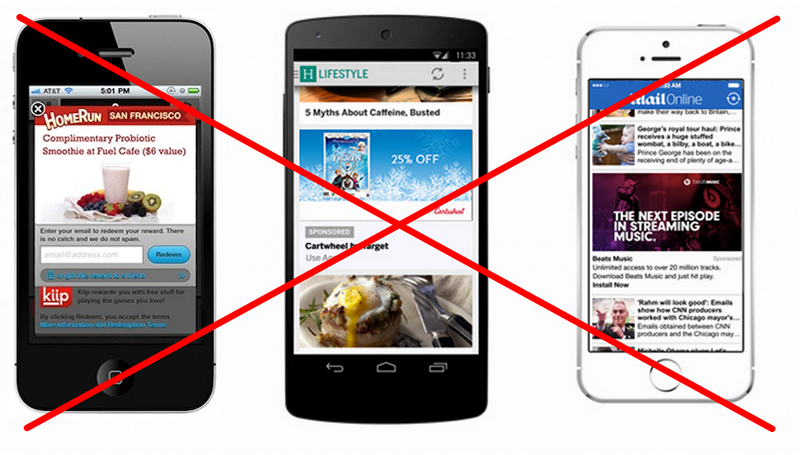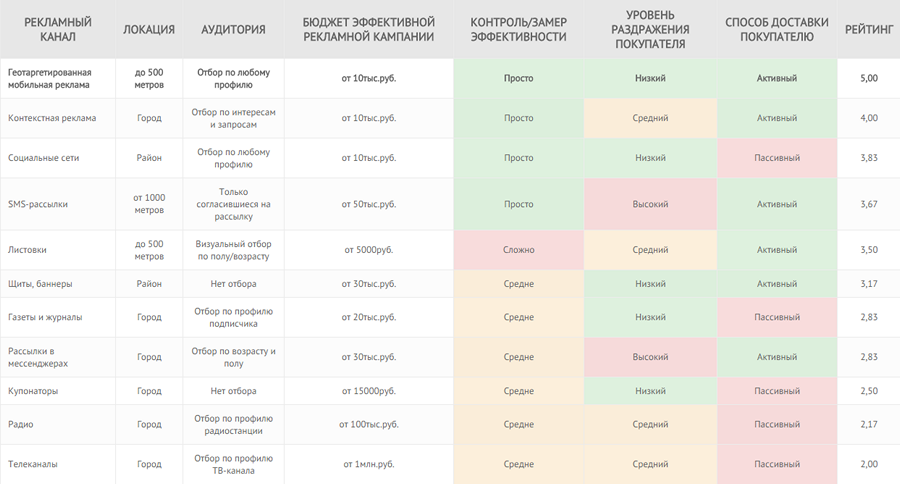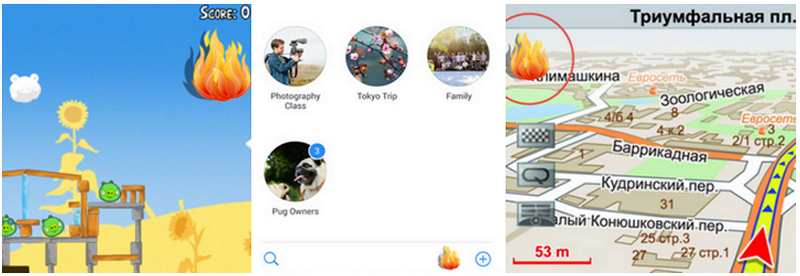Ad networks 3.0: how a developer to stop annoying users and earn more

A wide range of mobile advertising: from disturbing to terrifying. In any case, until 2016.
Advertising network through the eyes of a mobile developer
Every day more and more smartphones. It is becoming more and mobile applications. Because of this, competition among developers for advertisers is growing - after all, their number is clearly not increasing as quickly as the number of smartphone users. Result: developer revenue per user declines.
In order to compensate for the fall in revenues, developers are increasing the number of users in their applications by hook or by crook. The number of banners increases, users click worse, they have to increase the number of users again. Actually, all this does not happen with evil intent to enslave the world, but with a justified desire to go to zero and earn a little more.
The logical “food chain”?
Not.
With mobile advertising, everything initially went wrong. Trying to drag banners from the desktop, where they, in general, do not deliver significant interference, on the definition of limited screen sizes - a dead-end path. I don’t know about you, but on a 10 '' tablet I’m furious with something blinking down in a comfortable navigation zone. About interstitial banners and videos do not talk at all.
')
Moreover, the volume of the problem can be seen in the Finstrip from the developers themselves: one of the most good income is given by children's applications. Because kids click on everything. If the application does not end up in the ban, then the developer’s income is above average, but the advertiser does not receive any real conversion of buyers. The result is the same - the advertiser’s credibility for mobile advertising falls, he doesn’t see the effect and is therefore not ready to pay dearly.
 Yes, by the way about the mediators ( eng ). What's wrong with them? In fact, nothing, but for most developers, getting 30% more from a little money is still a little money. Your humble servant created in 2007 a mediator who manages the sale of SEO links. With zero investment, 3 employees and without the participation of any investors and funds, he earned several hundred million. But there the acceleration of customer income was completely different in absolute terms. Search engines have never liked this, and this is a topic for another conversation, but for the average client, the owner of a single site, the average income was measured in tens of thousands of rubles. After implementation, including real exchange algorithms, this income was raised by 200-500%, providing development opportunities for thousands of Runet sites (work was only with adequate resources, low quality ones were not accepted).
Yes, by the way about the mediators ( eng ). What's wrong with them? In fact, nothing, but for most developers, getting 30% more from a little money is still a little money. Your humble servant created in 2007 a mediator who manages the sale of SEO links. With zero investment, 3 employees and without the participation of any investors and funds, he earned several hundred million. But there the acceleration of customer income was completely different in absolute terms. Search engines have never liked this, and this is a topic for another conversation, but for the average client, the owner of a single site, the average income was measured in tens of thousands of rubles. After implementation, including real exchange algorithms, this income was raised by 200-500%, providing development opportunities for thousands of Runet sites (work was only with adequate resources, low quality ones were not accepted).And again, there was a much more transparent relationship with pricing than with mobile advertising. The sections of those forums where developers try to understand how they get money when using the interstatials video — for partial views, clicks or full views — have hundreds of pages. And unequivocal answers are still not found. Even on the sites of the advertising systems themselves.
The mediator is easy (flowchart of the Mira 2 mediator)
No exit?
However, advertising must be expensive, and mobile - all the more. And it is quite real.
 As one of the additional activities, for 10 years I have been directly involved in one resource of a rather narrow and completely non-commercial topic. Attendance for a long time was more than 10K unique visitors per month, but due to the lack of the possibility of direct monetization, he always balanced at the level of payback. Yandex.Direct bought impressions for nothing and at the output gave a maximum of 15,000 rubles. per month - what could pay off only the server rental and a third of the salary of one employee. SEO advertising gave about 60,000 rubles. per month. Nevertheless, a solution was found, and now advertising brings confident 300 000+ rubles.
As one of the additional activities, for 10 years I have been directly involved in one resource of a rather narrow and completely non-commercial topic. Attendance for a long time was more than 10K unique visitors per month, but due to the lack of the possibility of direct monetization, he always balanced at the level of payback. Yandex.Direct bought impressions for nothing and at the output gave a maximum of 15,000 rubles. per month - what could pay off only the server rental and a third of the salary of one employee. SEO advertising gave about 60,000 rubles. per month. Nevertheless, a solution was found, and now advertising brings confident 300 000+ rubles.The solution turned out to be simple and consisted in targeting. As Steve Blank ( eng ) in one of his councils recommends targeting narrow audiences, albeit with low attendance, so we finally realized who needed this audience and who it was for.
If your application has fillable profiles or integration with social networks - this is good. It is unlikely that someone will be surprised, and such things have long been used in networks of the 2nd generation, the distinguishing features of which are the consideration of behavioral and contextual factors, as well as the use of a social graph ( eng ).
Mobile phone gives a new, amazing opportunity compared to the desktop - geo-targeting. And if your application uses geolocation data, you are much closer to the first million in your favorite currency. The main thing is not to collect personal data in the definition of relevant laws and notify users that you can use their data to display targeted ads.
Stop! As a result, we still sell advertising in our applications to 1st generation ad networks for a penny and the 2nd generation network is a bit more expensive, and there are no other options. Or is there?
I will sell. Expensive.
Last year we were able to personally communicate with hundreds of advertisers. These were representatives of advertising agencies, not divorced from reality, not marketers who live in generous budgets, but real business owners. And we were interested in a completely down-to-earth, especially now non-commercial segment - small and medium business. We learned a lot of interesting things.
Do you know how much the seller of cellular accessories of one famous brand is willing to pay for the arrival of a buyer to it? 10 rubles, 100 rubles, 500 rubles? Not guessed. Up to 1000 rubles. Now imagine how much the jewelry manager or car dealer is willing to pay for one buyer.
What else interesting and terrible learned
Interesting: hated by all ads in elevators and mailboxes is also hated by advertisers, as in 95% of cases does not work.
Awful: more than half of advertisers, in principle, do not appreciate (or cannot evaluate) the conversion of certain types of advertising. Money rushes to the wind.
Awful: more than half of advertisers, in principle, do not appreciate (or cannot evaluate) the conversion of certain types of advertising. Money rushes to the wind.

The survey compared the effectiveness of advertising channels (online and offline). Audience: owners and managers of more than 200 outlets. A. Kravtsov, St. Petersburg 01.09–30.11.2015
The cost of a single customer is not the same as the cost of one display of advertising? Maybe. Perhaps it is even two diametrically opposite values. But not in the case of real targeting. When the representatives of the stores learned that with the help of a certain technology, it is possible to show personalized messages to smartphone users with a strictly defined portrait, and no farther than 500 meters from the outlet - they did not believe their ears at first, and then pronounced the Russian equivalent
“Shut up and take my money”
This was said even far from IT by the owner of a chain of butcher shops, I am not joking.
In fact, as on the Internet, contextual advertising has long put banner ads on the blades, so in the coming years, geo-targeted advertising will seriously reduce the force of meaningless carpet bombing of advertising on radio stations, from the TV screen, audio advertising in the subway and reduce the number of ugly stretch marks (which day saw 100,000 people and as many as three took advantage of). Oh, and by the way - distributors of leaflets will disappear too.
Thus, a distinctive feature of advertising networks 3.0 is the use of geo-targeting not as one of the additional features, but as a major factor complemented by behavioral and contextual ones. This allows us to offer both users and millions of physical outlets a fundamentally new level of service, merging more closely online and offline.

Carpet bombing vs Accuracy and accuracy (images from otownsports.com and smartnews.ru)
No annoying user
Advertisers are good, but what to do with your favorite users, who are always ready to throw heaps of minuses for any new advertising SDK? You can try to convince yourself that the application is free, so the user can suffer - but the sediment on the soul will remain.
Remember the last contextual advertisement you saw.
Try to recall any of the last banners you see. Yes, but AdBlock still does not cut 100% of advertising.
What infuriates more?
When asked what kind of advertising does not annoy the user, besides the most obvious answer, there is one such - an advertisement that meets the following requirements:
a) interesting. Fits my personal interests.
b) fast. It advertises what I can quickly, without delay, buy.
c) Profitable. It guarantees me financial gain and / or tangible savings.
Item a) is easy to understand due to normal, healthy targeting.
Item b) in the case of the smartphone is even easier to understand through geo-targeting. Buyers do not need to go somewhere, log in, wait for the courier. We will only advertise places that are physically close by.
An avid cyclist will pass a bicycle shop 50 meters away, when he will be offered a personalized discount of 15% on the model just released or 20% on accessories? Only if he is not avid. Coffee lover will refuse a free cup of coffee when buying a sandwich, passing on a frosty Sunday past a famous coffee network? Only if he has a cup of coffee in his hands. The owner of Lexus does not want ... Well, you already understood.
In point c) it is more difficult, here it is necessary to overcome the hated and never performed “discounts” of 80%. But there is a way.
 The quickest have already understood that this is both contextual advertising, but offline. But, unlike Yandex.Direct and Google Adwords, there are more abrupt opportunities in terms of what we can find out not only whether a person clicked on a product, but also whether he decided to buy it, how it was served and in general did he like everything? After all, he has a smartphone in his hands, with the help of which he can take a photo of the check with the price tag that the advertisement promised, and send a complaint to the advertising network service. The service checks the complaint within 48 hours and if something is wrong, the unlucky buyer pays double compensation to the bank card.
The quickest have already understood that this is both contextual advertising, but offline. But, unlike Yandex.Direct and Google Adwords, there are more abrupt opportunities in terms of what we can find out not only whether a person clicked on a product, but also whether he decided to buy it, how it was served and in general did he like everything? After all, he has a smartphone in his hands, with the help of which he can take a photo of the check with the price tag that the advertisement promised, and send a complaint to the advertising network service. The service checks the complaint within 48 hours and if something is wrong, the unlucky buyer pays double compensation to the bank card.At whose expense? Of course, due to the balance of the advertiser - he also puts money on him to unscrew the advertisement. Do not twist your finger at the temple - here the story is not about ideas or tomorrow, but about really working technologies. Advertisers are really willing to pay extra for their shoals if they sense future profit. (Yes, and cheating is impossible here again, due to the fact that each offer is sent to each user personally.). This, of course, is far from being implemented in all geo-targeted mobile networks, but there are such opportunities.
When comparing with classical contextual and banner networks, you can add two more points:
d) Timely. It does not advertise what I was looking for a month ago and bought a long time ago.
d) Not annoying. Do not climb into the eyes every minute. About this - in the next section.
Not annoying developer
Oddly enough - for the developer this is also a problem. To cut out a precious place under the banner area so that the vile “you won” got out there - not every creator can do that.
Guess, this problem is also solved. Look, you no longer need to show the user hundreds of banners in the hope that he will click at least somewhere. We show him personal offers that answer a) b) c) (interesting, fast, profitable). So they have a high CTR , right? In reality, about 20-30%. Since the CTR is high, we can show them less frequently and, therefore, we don’t need to constantly keep some area of the screen under them (or interfere with interstitial shows).
Instead of an endless display of banners, where the user clicks God forbid once a week (and even then by chance) and brings us $ 0.1, we will show him something personal and more expensive. Even if you do it only 3-4 times a week, then in the end it will bring us completely different money. And it will obviously irritate the user less.

How a notification inside applications may look like there is a personalized promotional offer nearby. When you click, a screen is displayed with the name of the outlet, its address, distance to it, the essence of the promotional offer for this user and its validity period. (Basic images from AngryBirds, koSocial, CityGuide applications)
The head of one of the companies-developers of navigators, included in the Russian TOP-5, assured that they are ready to show similar advertising to drivers standing at traffic lights or in traffic. For example, “At the next gas station (450 meters) a discount for 95th gasoline when refueling more than 30 liters is 6%.”
Pleasant bonus. Once the advertisement is geotargeted, then if we somehow showed the user a notification about the availability of an offer for him, but for one reason or another he decided not to click on it, then when he departs / departs a sufficient distance from the advertised outlet , then notification can be quiet and neatly hidden. The user will not need to swear, cursing.
And if the user still clicks on the offer? We remember that it is targeted, advertises what you can quickly buy and guarantees financial benefits? The user will see an interesting promotional offer for him and, you can be sure, his next appearance will be eagerly awaited. After all, who would refuse the really necessary thing behind the next door with a good and real discount?
Instead of a notification, the user can display, in general, banners, but not the usual ones, but geo-targeted ones. Which banner will the user click more willingly - “New collection of winter clothes in Okku” or “Guaranteed 15% discount in Okku for all winter clothes in the Omega shopping center (50 meters)”?
No surprises
 "Invalid actions were found in your account, so it is blocked." Surprise? Of course, no, because usually the unfortunate user is trying to get a couple of hundreds of unnecessary banners every day, and if he suddenly clicked on them 2 times a day - it’s horrible, it's cheating, this is a warning, and even better - the developer’s bank and the withdrawal are in their favor hard earned money.
"Invalid actions were found in your account, so it is blocked." Surprise? Of course, no, because usually the unfortunate user is trying to get a couple of hundreds of unnecessary banners every day, and if he suddenly clicked on them 2 times a day - it’s horrible, it's cheating, this is a warning, and even better - the developer’s bank and the withdrawal are in their favor hard earned money.You still remember that in the case of ultra-targeting, we essentially decide what to show to the user at what moment? If he was shown something 2 times, and he was not interested in or gave a negative connection - this is the reason for the alert on the ad network server. If you have done this 5 times, this is the reason for auto-tuning the algorithm. In our case, it is not normal if we showed him something, and he did NOT click, and not vice versa.
The network of the 3rd generation ultargett shows and therefore will not even mind if the developers are humane ways to motivate users to familiarize themselves with the promotional offer sent to them.
After all, from this all will be better - and the developer, and advertiser, and user. Win-win-win.
Total
According to all forecasts, in the next couple of years, the market will provide several dozens of extremely interesting ultra-targeted products for mobile platforms that will simply embellish mobile developers. Therefore…
Developer, do not let yourself hang! Remember - geo-targeted advertising should cost significantly more than $ 5 per 1000 impressions. Even for Russian users.
BONUS
Who is not in the subject
There are no truly generous offline advertisers for mobile developers here yet - no one will pay for a potential buyer who walks around another area of the city.

Google Adwords - Maximum geotargeting around the city (for Russia)

Yandex.Direct - Maximum geotargeting around the city
Yandex Media Mobile - “The minimum distance must be at least 1 km. from the outlet, and the maximum is up to 5 km "- too little to interest the majority of owners of off-line businesses

VK.com - Only street indication; for large cities with long streets this is not enough
RTB networks almost completely fall into category 2.0. Because of the general unification, the only geodata they can use is the IP address, and it sometimes gives an error within the city.
Who is almost in the subject - contenders for the title of a network of generation 2.0+
Applicants - because the network of the 3rd generation should be initially built around geodata, and not use them as one of the additions. Far from all meet these requirements.

Startapp.com - One of the largest ad networks
Technical details here .
Pros: Documentation explicitly declares a higher income in the case of geo-targeting
Minuses: There is no clear question price in case of its use; no advanced geo-targeting opportunities are provided for the advertiser

Appodeal.com - A dynamically developing mediator
Technical details for iOS and Android . Presented at Habré.
Pros: Combines many networks, allows you to raise income above average
Minuses: For Android, only ACCESS_COARSE_LOCATION is required, which gives an accuracy of no more than 2 kilometers - for full geotargeting is clearly not enough

myTarget from Mail.ru
Technical details here . Mail.ru is presented on Habré, but there is nothing about myTarget.
While in beta , but the largest Russian network. But in beta. Reports about 200 applications where integration has already been done.
Pros: If you get in the list of 200+, then you should immediately get access to a huge pool of advertisers. In the reviews about the basic network (without geo), developers report about eCPM $ 2, which is not bad for Russia. From the point of view of the advertiser, very advanced possibilities for creating a portrait of the buyer - if not for the minus (see below), then it would be a more obvious candidate for generation 3.0.
Cons: Beta. For some reason, the Android SDK does not require permissions for geolocation at all, although advertisers say this. Perhaps, geodata is taken only from its own applications.
The advertiser’s very complex interface (non-obvious terms, requires a different campaign for each data source) - clearly designed for advanced marketers rather than SMB representatives; support sometimes floats strongly in geo-targeting matters.
Who is already in the subject - contenders for the title of the network of generation 3.0
The presented networks (except the first participant) actually earned only in 2015. Not all provide opportunities for external developers.

Google now - Android’s built-in personalized search service (“google cards”)
From the point of view of advertising, it provides only individual functions so far, although their number is gradually expanding: 1) tips about the nearest cafes / restaurants, taking into account user search requests 2) new function of integration with AdWords ads “remind me when I'm close” ( eng )
Plus / minus: API is open only for the elite ( eng ), but if you get into the hundred applications allowed to it ...
Minus: It is not known how big a bet Google does is to “commercialize” user prompts - especially given the fact that the corporation is known for its unpredictability in relation to the closure of pilot projects.

LocalHero - Project AlterGeo experienced in terms of geolocation
There is no technical documentation, the parent company was represented on Habré 5 years ago.
Pros: Integrated into the current RTB infrastructure, redeem impressions on websites and in mobile applications; have extensive experience with geodata
Minuses: This is the same and minus - GEO can only be determined by IP with appropriate accuracy, therefore mobile impressions are no more than 30% ; their banners may already be shown in your applications, but they pay you as usual for non-geo shows. No sdk

402 Targeting - geo-targeting network
Technical details here and on Habré .
Pros: Almost fully implemented what is described above; there are more advertisers than publishers - so at the moment new developers are invited on conditions of guaranteed payment for the first month
Cons: SDK for Android only; ransom only Russian users (but expensive)

Skyhook - Not really a network, but provides an interesting set of tools.
For example, allows you to independently determine the offline interests of users.
Pros: Allows you to sell an expensive audience directly to the advertiser (i.e., very expensive)
Cons: Only suitable for tangible MAU and clearly not a boxed solution

xAd.com - Platform Solution for Geomarketing
Pros and cons are not yet obvious, because connection procedure is not clear.
Source: https://habr.com/ru/post/276119/
All Articles
